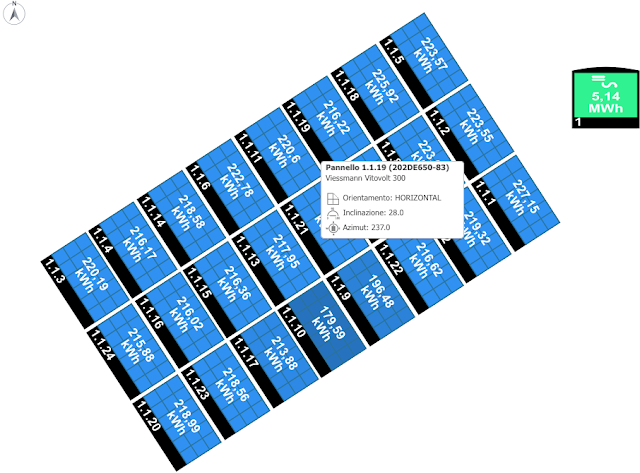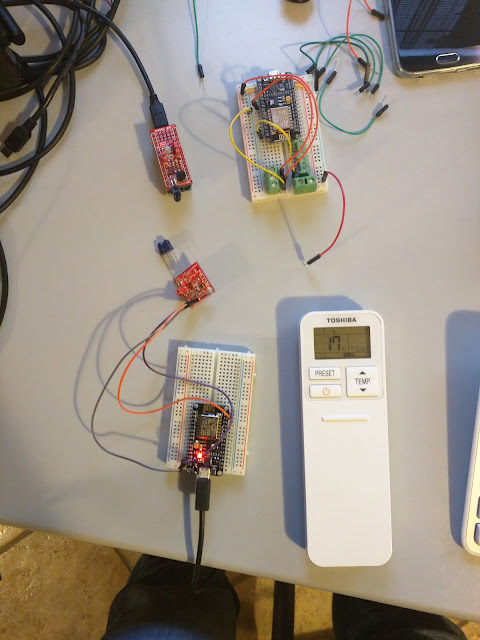Tesla Powerwall II - Is it worth it for my use case?
Introduction
We have installed a photovoltaic system about one year ago, and have been logging solar production and house energy consumption since.
As of this month we have enough logging data to start looking into the economic value of adding a storage system, specifically the new Tesla Powerwall in order to improve the auto consumed amount of energy.
TL;DR: It's not worth it, yet :)
Background - Photovoltaic System
Our photovoltaic system is composed by 24 Viessmann Vitovolt 300 Panels@250Wp, for a theoretical peak power of 6kWp.The system is installed on our rooftop, and is Oriented in a W-SW configuration (Azimut@237 Degrees) with a 28 Degrees inclination, located in Northern Italy.

As it can be seen by the lower production numbers of two panels, we have a chimney that casts an important shadow on two panels (1.1.9 and 1.1.10), and we have some shadow cast by some huge trees on a neighbour's property that basically block solar radiation from 6PM onwards from spring to autumn.
The system uses Solaredge micro-inverters on the rooftop and a SolarEdge SE6000 inverter that takes care of feeding AC current into the house/to the Electric company. The micro-inverters allow for the system to be configured in a single string without loss of efficiency of panels not covered by shadows.
Peak performance - real has been observed at around 5.7kWp
Any amount of energy produced that is not consumed in place is sold to the local Electric company for about 0,12 EUR/kWh. On average we save about 0,25 EUR for every kWh of energy that is auto-consumed.



Photovoltaic System - ROI
If weather conditions remain similar, and if our consuming patterns do not change too much, I expect the savings on auto-consumed energy plus the income that arises from selling surplus energy will repay in full the cost of the solar system in 4-5 years, with a projected ROI over 10 years of about 5% net.
House - Energy Balance
| MONTHS | SOLAR PRODUCTION | GRID IMPORT | GRID EXPORT | HOUSE CONSUMPTION | OWN CONSUMPTION | % Auto Consumption |
| Jan | 311,8 | 440,3 | 164,5 | 575,2 | 134,9 | 23,45% |
| Feb | 304,5 | 352,6 | 182,4 | 463,8 | 111,2 | 23,98% |
| Mar | 599,9 | 299,8 | 434,5 | 452,1 | 152,3 | 33,69% |
| Apr | 726,6 | 293,5 | 533,1 | 474,1 | 180,6 | 38,09% |
| May | 837,4 | 273,4 | 560,7 | 512,7 | 239,3 | 46,67% |
| Jun | 883,9 | 232,3 | 576,3 | 527,4 | 295,1 | 55,95% |
| Jul | 911,3 | 227,1 | 640,7 | 483,8 | 256,7 | 53,06% |
| Aug | 751 | 296,7 | 439,6 | 594,7 | 298 | 50,11% |
| Sep | 641,6 | 237 | 430,3 | 436,1 | 199,1 | 45,65% |
| Oct | 403,4 | 338 | 237,7 | 491,7 | 153,7 | 31,26% |
| Nov | 255,9 | 424,9 | 123,8 | 545,8 | 120,9 | 22,15% |
| Dec | 254 | 445,4 | 131,4 | 556,4 | 111 | 19,95% |
| Grand Total | 6881,3 | 3861 | 4455 | 6113,8 | 2252,8 | 36,85% |
All in all, we produce a little more energy than we consume, and that is already a great result in terms of energy footprint of our house.
As it can be seen from the data, auto-consumption is pretty high during spring and summer, and goes down during fall-winter as expected, adding a battery storage option would allow us to increase the amount of auto-consumed energy, the question is, given the cost of the system wether it is worth it.
Tesla Powerwall 2 - is it worth it in our case?
The new Tesla Powerwall system is a 13kWp battery that promises near infinite recharge cycles but when reading the fine print it turns out near infinite is around 10.000 cycles, give or take, with some loss of efficiency.This means the expected life of the storage system is about 25 years.
The cost of the system here in Italy has been estimated (by me) to be at around 11K-12K EUR, with the possibility to deduct 50% in 10 years when doing tax returns, and that brings the cost over 10 years to an estimated 5.5K EUR.
The cost estimate is much higher than the battery alone because the Solaredge inverter needs an additional interface in order to be able to integrate the Powerwall, and some modifications to the electrical system are needed because of the need to install an additional energy meter that is used by the inverter to decide when to store energy in the Powerwall and when to push it to the rest of the system
We calculated, given the daily solar production for the past year, how much surplus energy could have been used to charge the Powerwall instead of being sold to the Electric company. We also calculated how much of the stored energy could be reused day by day in order to have a good approximation of how a Powerwall would be used in our case.
-->
| MONTHS | SOLAR PRODUCTION | HOUSE CONSUMPTION | OWN CONSUMPTION | POWERWALL CHARGE | POWERWALL SAVE | POWERWALL REMAIN | % Auto Consumption Powerwall |
| Jan | 311,8 | 575,2 | 134,9 | 164,5 | 164,5 | 0 | 52,05% |
| Feb | 304,5 | 463,8 | 111,2 | 174,9 | 164,8 | 10,1 | 59,51% |
| Mar | 599,9 | 452,1 | 152,3 | 331,3 | 225,2 | 106,1 | 83,50% |
| Apr | 726,6 | 474,1 | 180,6 | 349,5 | 261,2 | 88,3 | 93,19% |
| May | 837,4 | 512,7 | 239,3 | 384,8 | 257,8 | 127 | 96,96% |
| Jun | 883,9 | 527,4 | 295,1 | 375,3 | 218 | 157,3 | 97,29% |
| Jul | 911,3 | 483,8 | 256,7 | 396,7 | 217,5 | 179,2 | 98,02% |
| Aug | 751 | 594,7 | 298 | 360,6 | 257,8 | 102,8 | 93,46% |
| Sep | 641,6 | 436,1 | 199,1 | 376 | 226,7 | 149,3 | 97,64% |
| Oct | 403,4 | 491,7 | 153,7 | 245,1 | 212,6 | 32,5 | 74,50% |
| Nov | 255,9 | 545,8 | 120,9 | 124,3 | 123,8 | 0,5 | 44,83% |
| Dec | 254 | 556,4 | 111 | 131,4 | 131,4 | 0 | 43,57% |
| Grand Total | 6881,3 | 6113,8 | 2252,8 | 3414,4 | 2461,3 | 953,1 | 77,11% |
Unfortunately, while the addition of a Powerwall to our system would bring auto-consumption to an excellent 77% on average, with almost complete energy independency from April to September, the potential savings coming from this would amount to about 320EUR/Year, so it would take 17 years to get even with the investment without taking energy cost variations into account, but even a 12 year target would not be good, given the risks involved in assuming there will be no need for maintenance and the technology will deliver on the 10K cycles.
All in all, we will keep our system as it is and keep monitoring so by the time Battery Storage costs go down or Energy cost rise too much we will be able to revisit the calculation.



Commenti
Posta un commento